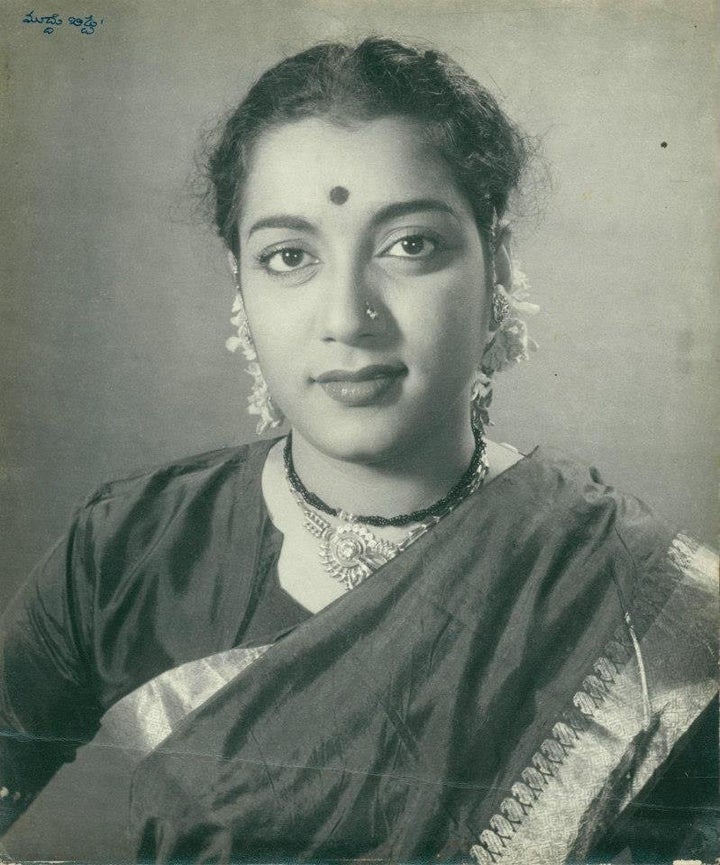
Sixty years ago, an Indian filmmaker made a movie about a woman forced to stop her studies and marry an older, unfaithful man. The subject is not unusual. Many movies have depicted women in such a predicament. They weep, pray and reform their husbands. In Puttillu, though, the woman does something rarely seen even in today's Bollywood.
She sees through him, and she leaves him.
The actress who played that woman was my mother, Jamuna. She was just sixteen years old, a child of the village facing a city, and a profession deemed disreputable for women, for the first time. It was not an auspicious debut. Puttillu was condemned as an affront to womanhood and failed at the box-office.
It should have been the end of her career. But it wasn't. She went on to act in nearly 200 films -- in four languages, at that -- though even that might not have been. A pair of leading male stars, around whom the whole business revolved, suddenly proclaimed a casting embargo against her. They said she was arrogant. She said a woman had a right to her own dignity. She survived that too.
Then, many years later, she had an on-set accident; an actor fell on her head during a song. In time, its effects started to show, especially in close-up. When she wept, her head trembled. Worse, weeping, and looking old, was what her roles called for by this time. Her male cohorts still played young men, even her sons. It was implausible. They looked old and fat, she didn't. But India's cinematic cult was always of hero-worship. Finally, after thirty years in the industry, she left movies for politics. In politics too, she found a male culture hesitant to accept a woman as equal. She still won an election to Parliament.
I grew up in the shadow of my mother's stardom. But it was only with the experience of growing up and working (and along the way, getting an education in a critical academic tradition), that I learned to see her story as that of a woman who worked, and in a work culture legendarily subservient to male power. I sometimes hear from women of my mother's generation about what she meant to them. I used to think the admiration was for her image, the roles she played, like the goddess Satyabhama (who even kicks the crown off Krishna's head in one movie); a Mughal empress; a modern working woman (an I.A.S. officer, whose estranged husband now ends up as her subordinate, no less!); and of course, a good Indian mother and wife, too. But the admiration, I now realize, was more than symbolic; it was also for the fact that she worked.
On a recent visit to India, I accompanied my mother to the village where she lived before becoming famous. She was invited to speak to students at a local college there. She urged them to join the protests sweeping India in the wake of the brutal New Delhi gang-rape. Later, she joined film industry colleagues on a protest march in Hyderabad demanding a change in India's attitudes towards women. It was an inspiring moment. But I had to wonder though about what has changed in the industry.
In the 1950s, despite the adversities my mother faced in her career, there were roles which, even in the guise of tradition, expressed female agency. There was also relatively little on-screen violence against women then. The decline, some might say, began with the rise of action films in the 1970s. Women became increasingly caricatured as either sex objects or as pious mothers. The formula for romance was even reduced to something as venal as poor boy-slaps-rich-girl (and that makes her fall in love). In the last decade, though, a few movies have sought to restore women's agency in the narrative, but films like Kahaani or English-Vinglish stand out only because they are exceptions. As for the rest, they seem to have only one space for women to show spirit, and that is the celebrated "item song," with its spectacle of a dancing woman surrounded by hordes of drooling men.
The trouble with the debate in India on women and cinema, and culture, more broadly, is that in our eagerness to safeguard our political positions, we forget the obvious. Aging Indian conservatism blames the intrusion of Western culture and clothing into Bharat for all the problems we have with men and women today. An assertive, newer liberal sensibility haughtily blames a monolithic idea of the past, especially religion, as if the newer forms of media and globalization do not need to answer for their persistent normalization of objectification (or shall we call it "itemization"?) and brutality against women. I know that someone of my mother's generation and experience would perhaps lean towards the former rather than the latter, towards the sensibilities that in the English-speaking media world, we tend to view "Bharat" disdainfully as a right-wing fantasy. But, despite her occasionally anachronistic views on clothing and parties, I know that she represents a bolder struggle as a woman in a male-dominated industry and public culture than our patronizing view of our past may give credit for. I know that a movie like Puttillu could not have been made if our elders too did not know, in their own way, perhaps, that the world needed to change. It may be true that in the old movies, women were typecast as good wives and mothers, but we cannot believe that the only alternative to that is only to be typecast as sexual objects either. Sometimes, as in Puttillu, a woman can just be who she is too.
This post was first published in the Indian Express.
